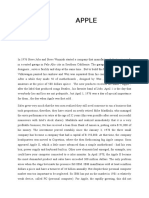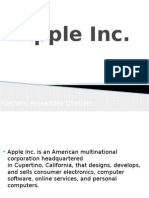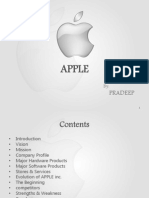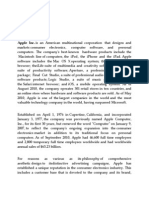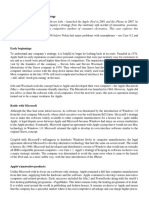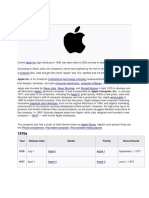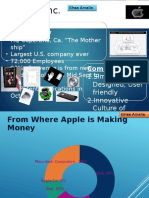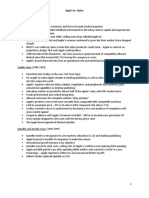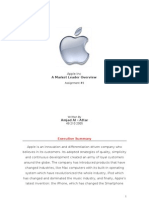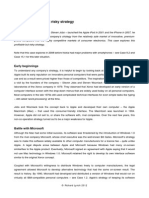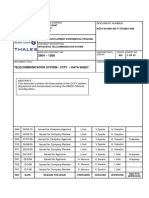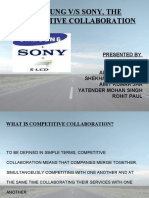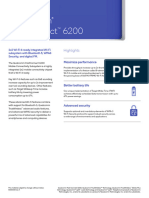must explain detail descriptions on innovation sources were provided.
for example
Sources of Innovation
1)Unexpected Occurrences
2)Incongruities
3)Process Needs
4)Industry and Market Changes
5)Demographic Changes
6)Perceptual Changes
7)Knowledge-Based Concepts
can refer topic 3.6
you can choose any organisation
Pilih sebuah organisasi; huraikan sumber-sumber inovasi yang diperoleh oleh organisasi
pilihan.
Berdasarkan soalan assignment,bolehkah saya pilih sekolah sebagai organisasi ?
Kenal pasti dan bincang halangan-halangan kepada inovasi yang dihadapi oleh GURU.
Cadangkan penambahbaikan yang boleh dilaksanakan olehSEKOLAH dalam menyemai
budaya inovasi di kalangan MURID-MURID.
Apple's history in nine innovations
Apple turns 40 this week, with CEO Tim Cook acknowledging the
milestone at the firm's launch of the iPhone SE last week. Marketing
explores the firm's history through nine key innovations.
313
image:
http://cached.imagescaler.hbpl.co.uk/resize/scaleWidth/743/offlinehb
pl.hbpl.co.uk/news/OMC/thinkdifferentcropped-
20160330101949152.jpg
� Appl
e: marking forty years of innovation on April 1
FORMATION OF APPLE01 APRIL 1976
image: http://offlinehbpl.hbpl.co.uk/news/OMC/richedit/logoo.jpg
�Apple Computer Inc was founded on 1 April 1976 by Steve Jobs and Steve Wozniak to
commercialise a computer that Wozniak built, the first computer with a keyboard and a
connection to a TV. Jobs priced the Apple I model at $666.66.
1984
FIRST MAC24 JANUARY 1984
image: http://offlinehbpl.hbpl.co.uk/news/OMC/richedit/mc2.jpg
�The Macintosh, named after a type of apple, was Apple’s first computer with a graphical
interface, aimed at small business and home users. It introduced a visual design led ethos
with the desktop and icons. It was priced at $2,495 and promoted with the ‘1984’ ad by
Ridley Scott, placed in a 60-second spot in the Super Bowl. The machine and its software
appealed to the design community.
Brand rival: IBM - the ‘1984’ ad was a coded swipe at the status quo of computing in which
IBM was dominant
1998
IMAC15 AUGUST 1998
image:
http://offlinehbpl.hbpl.co.uk/news/OMC/richedit/2180218502_4f6874
1618_o.jpg
The iMac was a watershed for Apple in two ways. First, it was the first major product of Steve
Jobs’ second stint at the company, from which he had been ousted in 1985. In the 1990s
Apple had expanded into several different product sectors, such as digital cameras, CD
players and handheld computer the Apple Newton, but Jobs cut everything back to desktop
and laptop computers. Second, it shook up the design of hitherto beige, boxy personal
computers with vivid colours and aesthetically pleasing curves, with design genius Jony Ive
making his mark under Jobs.
Brand rival: Compaq - the then leading brand by personal computer market share
2001
APPLE STORE19 MAY 2001
�image: http://offlinehbpl.hbpl.co.uk/news/OMC/richedit/Applest.jpg
While Apple has hundreds of dedicated stores around the world now, it only sold through
other retailers before 2001 (apart from launching an online store in 1997). Jobs wanted to
take more control of how Apple’s products were presented and sold, and bemoaned the fact
that retailers preferred to promote cheap PCs to customers. It cut the number of third-party
retailers selling Macs from 20,000 to 11,000 between 1997 and 2000. The first two Apple
Stores were opened on the same day in May 2001, one on each coast of the US. The first UK
store opened in Regent Street in 2004 and the iconic New York Fifth Avenue store (pictured)
in 2006. Jobs told Forbes in 2007: "Our stores were conceived and built for this moment in
time - to roll out iPhone."
Brand rival: Dell was riding high having carved out a profitable niche selling direct to
consumers. Founder Michael Dell had said when asked how he would fix Apple: “I’d shut it
down and give the money back to the shareholders”
IPOD23 OCTOBER 2001
image: http://offlinehbpl.hbpl.co.uk/news/OMC/richedit/classic.jpg
�The iPod started the Apple rock rolling through the music industry. The company looked at
other digital music players in the market and came out with its own revolutionary, well-
designed take, intended to work seamlessly with the iTunes music player software it had
introduced the year before. The first iPod featured a scrolling wheel and saw the brand
appropriate the colour white to stand out from the crowd. It was also promoted with the
memorable promise of “1,000 songs in your pocket.
Brand rival: Sony - the Japanese company that invented the iconic 1980s Walkman portable
cassette recorder was thoroughly overhauled by the iPod
2007
IPHONE29 JUNE 2007
image: http://offlinehbpl.hbpl.co.uk/news/OMC/richedit/iphp1.jpg
Mobile phone manufacturers and many others doubted that a computer company would be
able to pull off the move into a completely different market. Among them was Microsoft’s
chief executive Steve Ballmer who said: "There is no chance that the iPhone is going to get
any significant market share". But the appeal of the iPhone solidified Apple’s reputation as a
brand that could do no wrong and demonstrated Jobs’ understanding of consumer desires
and mastery of the product reveal.
Brand rival: Nokia - the undisputed leader in mobile phones at the advent of the iPhone
would crumble within the space of a few years
2008
APP STORE10 JULY 2008
image: http://offlinehbpl.hbpl.co.uk/news/OMC/richedit/appstore.png
�The software counterpart to the iPhone allowed Apple to further control a user’s experience
as well as shaking up the publishing and games industries. There have been over 100bn
downloads from the App Store since its launch.
Brand rival: Google - the search company’s domination of how people navigated the internet
suddenly had a rival with Apple’s app ecosystem offering a new gateway to the online world
2010
IPAD03 APRIL 2010
image: http://offlinehbpl.hbpl.co.uk/news/OMC/richedit/ipadd.jpg
It has since become evident that tablets are not going to take over the tech world, but when
the iPad came on the scene it was rapturously received by Apple’s followers, with millions
�shelling out to add the new device to their iPortfolios. Moreover, advances in the way its
family of devices worked together over the cloud extended Apple’s lead in usability and
simplicity.
Brand rival: Microsoft - back in 2002 Microsoft has released its own tablet computer, but as
so often Apple reaped the benefits by applying a magic touch to what already existed
2015
APPLE WATCH24 APRIL 2015
image: http://offlinehbpl.hbpl.co.uk/news/OMC/richedit/watc.jpg
For most people the jury is out on the Apple Watch, with the company still guarding sales
figures a year after the first units shipped. Paving the way for the product meant making a
considerable stretch for the brand from the world of tech geekery to the rarified world of
fashion and luxury. Apple made a $17,000 gold version, the Apple Watch Edition, and sought
display space alongside high-end traditional watch brands in upscale department stores. Just
as expensive was the hire of Burberry CEO Angela Ahrendts, who earned $70m in her first
year at the company.
Brand rival: Take your pick from any company trying to get established in the wearable tech
market – Nike, Fitbit, Jawbone, Samsung, Pebble – or even Amazon, which might blindside
Apple with its by pursuing a different opportunity with its internet-connected Echo assistant.
http://www.campaignlive.co.uk/article/apples-history-nine-
innovations/1356079
https://www.zhihu.com/question/24290336
� Sources of Innovation:
Apple, Inc. Products
FEBRUARY 27, 2012 MYLES J. ROBINSON
Below is the second one-pager I wrote for my entrepreneurship seminar. We were
asked to describe the sources of innovation for an Apple product…
With the world expanding more globally, it’s becoming increasingly harder to not
only dominate a particular field but simply to break into a new market. When one
begins to talk about examples of successful innovation, Apple is undeniably a
significant part of the conversation. Annually recognized as the largest technology
company in the world by revenue and profit, Apple is able to continue its success due
to three of Drucker’s essential sources of innovation: industry and market structure,
process needs, and changes in perception.
Over the past thirty years, Apple has been able to become the leader in consumer
electronics by revolutionizing their industry and market structure. Drucker states only
simple, specific strategies have any chance of succeeding in entrepreneurship. In
agreement, Apple began with a very simple vision in 1977: make computers
affordable to all people, not just the computer professionals in business and higher
education. But as we discussed in class, an entrepreneurial activity is successfully
characterized by deliberate execution in conjunction with a good idea. Almost single-
handedly, Apple created its own business market in 1977 with the introduction of the
Apple II, which came with the VisiCalc spreadsheet program. Because of the
program’s compatibility with the office, home users were given an extra incentive to
buy the product. Similarly done thirty-three years later in 2010 with the iPad, Apple
created demand for its product where demand wasn’t initially present. Steve Jobs’
knack for being able to constantly “push the envelope” has made for a modernized
market and continued successful innovation throughout the electronic industry.
Apple has also been able to consistently provide innovative products due to their
ability to identify process needs. As Drucker references, necessity is the mother of all
innovations. By correctly identifying the consumer demand in the market, any
company automatically has an opportunity to succeed. Apple has taken this notion
and applied it to its entire business model. Ironically, Steve Jobs admitted to doing no
type of market research while working at Apple. Instead, he pushes Apple to
anticipate where the market will be in the future rather than reacting to its current
position in society. Chancellor Thorp and Professor Goldstein identify this practice as
achieving a sustainable competitive advantage. After his company’s failure with the
Apple III in 1980, Steve Jobs’ subsequent visit to Xerox PARC convinced him all
future computers needed a graphical user interface (GUI). The next computer model,
the Apple Lisa, helped Apple generate more capital, at the time, than any IPO since
Ford Motor Company in 1956. By gravitating towards innovation, not emulation,
Apple was able to clearly delineate its success before ever attempting to measure it.
The company continues to operate on the premises that consumers will express their
needs by what they already know they want: a bigger, faster, cheaper product. Apple’s
ability to identify consumer demand for their product and execute a strategic plan to
address consumer needs has facilitated in its innovative practices.
�Lastly, Apple’s products are sources of innovation due to changes in the company’s
perception. Steve Jobs’ original firing at Apple is well documented, but many
overlook the determination and new focus he brought back to the company he co-
founded when he returned in 1996. Under Jobs’ guidance, Apple dramatically
increased sales by introducing iMac and other products that featured more appealing
designs. With the introduction of the iPod, iTunes store, and iPhone, Apple began
branching out and improving its digital appliances, becoming known as the
multinational corporation it is recognized as today. Simon Sinek, a motivational
speaker known for his introduction of “The Golden Circle” concept during a TEDx
talk, argues that most companies lead with messages about whatthey sell. Great
CEOs, Sinek advises, take the extra step and communicate why they do what they do.
In a masterful way, Steve Jobs and Apple have created a market where people don’t
simply buy Apple products because they’re great, but because they are also buying
into Apple’s vision of why they’re great.Jobs has been an influential figure in
revamping Apple’s image and creating the powerful brand many consumers know and
love today.
Renowned as a leader in consumer electronics, Apple Inc. is globally recognized for
their groundbreaking practices due to their industry and market structure,
identification of process needs, and changes in their company perception.


